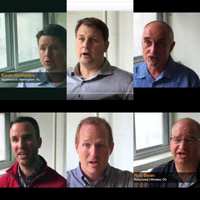CMS Practitioners Bullish on Future of Digital Marketing

:: Practitioners see many challenges, but surprisingly optimistic about what lies ahead ::
Content management system (CMS) vendors often grab the headlines, as they are the ones doing the "heavy lifting" by designing new software releases and rolling out entirely new platforms that connect brands with customers like never before. Yet, a great source of information lies the next tier down with the digital solution partners who implement and support these marketing technologies on a daily basis. It is they who have a clear and unobstructed view of the playing field. A number of them recently gathered in Toronto and offered a surprisingly bullish view of the digital marketing industry - and what lies ahead.

Digital Transformation: Coming to a Website Near You
Websites were, of course, front and center at this meeting, as they are where the CMS industry got its start. "I think websites are always going to be the baseline, they're always going to be the front door for any company going forward," said Kevin Grohoske of Sparkhound. "They're going to be the old storefront to the business."
"Websites aren't going anywhere," agreed Stephen Medeve of Falcon Software, "but they are going to change. The data model is going to changemore intrusive information will be asked of you."
Indeed. The amount of information that brands are collecting from online visitors is growing in leaps and bounds, enabling them to design an experience that connects people with the products and services that they are looking for in less and less time.
"There are extremely good people behind the helms of a lot of these big brands," observed Medve. "They have transformed their sites into analytical data repositories that understand and describe customers and then are able to sell to customers. This now starting to catch up with medium-size companies, which is the bulk of companies out there."

Website Accessibility: Regulation or Business Necessity?
Another aspect of digital transformation discussed in Toronto was website accessibility, an area where solution partners have developed quite a bit of expertise. "According to research that we've looked at," said Keith Durrant of ecentricarts, "about 20 percent of the overall population has some sort of accessibility issues. That includes people with motor skills challenges, of course visually impaired make up a large proportion of people having trouble accessing websites. So, when you think about it, it's potentially a very large audience that will benefit from making websites accessible."

He continued, "When it comes to creating a new office building, for example, you would put in ways for wheelchairs to access the building. People just do that as a normal course of construction now. And I think we're getting to the point where with websites people are starting to have the same type of philosophy, that there's no reason that you would want to put barriers up to keep anyone from using your website - especially when those people are consumers. They buy things, they buy their services, so why would you intentionally put barriers for people getting access to what you do?"
The good news here is that a single governmental body has written the specifications for website accessibility (Web Content Accessibility Guidelines (WCAG) 2.0), and they are being cited by governments not just in the Americas, but also in EMEA and APAC.
Content May Indeed be King - but Who's Going to Create It?
 "Fresh Content" is perhaps one of the most talked about topics in the digital marketing industry, and this meeting of solution partners was no exception. The industry, as a whole, seems fixated on producing Web content that is both new and constantly being refreshed.
"Fresh Content" is perhaps one of the most talked about topics in the digital marketing industry, and this meeting of solution partners was no exception. The industry, as a whole, seems fixated on producing Web content that is both new and constantly being refreshed.
According to Adam Hostetter of Notchpoint, "The single biggest challenge with clients in my experience," said Hostetter, "is developing that fresh content. And what it means is content that is search engine optimized, that's of interest, that's topical. You can solve all sorts of technology problems with the tools that you implement, but having good content is still the single most important thing you can do for your organization."
He continued, "We were talking before about teaching creativity in schools, and that's another problem that we're seeing. Students coming out of universities don't know how to write. There's no substitute for someone who knows how to write well. If you're not a good writer, it's tough to come up with that fresh content that is required."
All one has to do is look at the online job listings to get a sense of just how important this one role has become. Listings for "content writers" abound.
Headless CMS and Omnichannel Communication
Two more widely used terms that pop up in digital marketing circles are "Headless CMS" and "Omnichannel Distribution." And this meeting was no exception. The former term refers to separating the production of content from the distribution of content. The great benefit here is that you enter the content into the system only once, and you can adapt it for delivery to any Internet of Things (IoT) screen or device later on. That's where the second term comes in. It refers to the long and growing list of places where one can today deliver a marketing message, and it ranges from computer desktops, tablets, smart phones, and digital billboards to automobile consoles, elevators, and even gasoline pumps.

"The digital experience is omnichannel," emphasized Bruce Williams of Thundertech, "because that's where your audience is. The website is that authority place that can always drive a lot of your content marketing and the major publishing elements that are needed today for both education and awareness, but it is most definitely omnichannel."
That being said, Refactored's Rob Bean cautions companies to take one step at a time and not try to do it all. "Just because you can communicate everywhere does not mean that you should," said Bean. "I have yet to find a client that has unlimited resources and can hit every channel at the same level. It could be the level of client that we're working with, but for the most part we do try to provide focus and remind them that unless you've got a certain way to sustain an effort, don't try to do everything."
No "Easy Button" for Digital Marketing
 Bean also pointed out that what many companies seem to want is an "easy button" that they can press and then they don't have to worry about digital marketing anymore. But it simply doesn't work that way.
Bean also pointed out that what many companies seem to want is an "easy button" that they can press and then they don't have to worry about digital marketing anymore. But it simply doesn't work that way.
"Everybody that's been doing websites - they are probably on their fifth or sixth version of their site," explained Bean. "The same with email nurturing tools. People have tried a variety of solutions. And I think they are always looking for the ‘easy button.' They want to buy a technology that's easy enough that they don't have to think about it. And I think that unfortunately is what still prevails. ‘I am going to buy the better, newer tool' and it may do a little bit more than their last tool. But at the end of the day I think that's why our focus in on message and content, not on technology, because things will always get easier or better or slightly different in some new way, but if your message is off and you're not resonating with the customer, it doesn't matter what tool it's going through, it's still not going to be that effective."
Communicating with Multiple Generations of Consumers
Another topic that generated a lot of discussion was figuring out how to market and sell to a target that's changing all the time. Baby Boomers are beginning to leave the work force in significant numbers. They are rapidly being supplanted by Generation Xers, Millennials, and even Generation Y. And the way that these newer generations interact with one another and find information is strikingly different from those of us in the workplace today.
 "I have two teenagers at home," offered Keith Durrant of ecentricarts, "so I find their media consumption habits very interesting. First off, they don't watch television at all, which is amazing, because I still like watching TV occasionally. They certainly go to websites, but it's always on their phone. Even though we have multiple computers in our house and they have laptops, they do the majority of their surfing on a telephone. So, I think that device, which they've grown up with, is their primary access point, even to the Web."
"I have two teenagers at home," offered Keith Durrant of ecentricarts, "so I find their media consumption habits very interesting. First off, they don't watch television at all, which is amazing, because I still like watching TV occasionally. They certainly go to websites, but it's always on their phone. Even though we have multiple computers in our house and they have laptops, they do the majority of their surfing on a telephone. So, I think that device, which they've grown up with, is their primary access point, even to the Web."
Sparkhounds' Kevin Grohoske couldn't agree more. "My son has friends all over the world, some whom he's never actually met. But he considers them close friends because he's always socializing with them online. And so, some of the older-style marketing isn't going to reach those people in the same way that these Millennials or whatever. They look at the world a different way, interact with their environment in a different way. They look at the Internet and online chat as the way to have a conversation around the coffee pot. The way to press the flesh with somebody is to send them a text over the phone or through online chat. We didn't grow up that way. I got off the school bus at the end of the day and I'd get my friends together and say, ‘what sport are we going to play today?' They don't do that anymore."
‘There's no way it can get any better than that'
As this meeting began to wind down, the discussion turned to how far the digital marketing industry has come - and how far it has yet to go.
 "I remember when search engines first came out," concluded Grohoske. "And Google came out, and we were, ‘Oh, my gosh. They can catalog the entire Internet, which was tiny at the time. And we thought, ‘There's no way that it can get any better than that.' Now we have Siri in our pocket. We have personal assistants. We're going to have artificial intelligence. And all of these things are going to come together and start to create a mashing of technologiesThese are things we wouldn't have thought about 10 or 15 years ago. But we're capable of doing it now with the technology that we have. So I think that's what it's going to be, something totally creative and out of the box. There's probably going to be this moment of inspiration and then within the next 5 or 10 years, that's going to be the way to do digital marketingthere's going to be a change because how we market today is not going to work with the generation that grew up on video games, smart phones, and chatting with people all over the world."
"I remember when search engines first came out," concluded Grohoske. "And Google came out, and we were, ‘Oh, my gosh. They can catalog the entire Internet, which was tiny at the time. And we thought, ‘There's no way that it can get any better than that.' Now we have Siri in our pocket. We have personal assistants. We're going to have artificial intelligence. And all of these things are going to come together and start to create a mashing of technologiesThese are things we wouldn't have thought about 10 or 15 years ago. But we're capable of doing it now with the technology that we have. So I think that's what it's going to be, something totally creative and out of the box. There's probably going to be this moment of inspiration and then within the next 5 or 10 years, that's going to be the way to do digital marketingthere's going to be a change because how we market today is not going to work with the generation that grew up on video games, smart phones, and chatting with people all over the world."
About the Author
Jim Panagas is the director of PR and analyst relations for Kentico Software, a leading provider of CMS technology. He's a seasoned marketing and communications professional who has been working in the high-tech industry for more than 20 years. His current assignment is educating the market about digital experience platforms including Kentico EMS and Kentico Cloud.
YouTube links to the videos quoted above:
- Adam Hostetter: Fresh content, info from outside customers
- Bruce Williams: Digital experience is omnichannel
- Keith Durrant: How people consume content is changing, 20% of population has access issues
- Kevin Grohoske: Websites are becoming the old storefronts, people we market to are changing, future of digital marketing
- Rob Bean: Because you can communicate everywhere doesn't mean that you should, no easy button
- Stephen Medve: Web brochure to analytical repository

Subscribe to Our Newsletter!
Latest in Software








